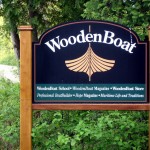 The center of the universe for people interested in wooden boats is Brooklin Maine. Don’t let anyone else fool you. The people in Brooklin will set you right. Brooklin is a little place on Maine’s central coast with a winter population of about 650 people. The WoodenBoat magazine, and others, is published from Brooklin. Nearby are 7 to 9 (depends on who counts) thriving boat shops, many of them building mostly with wood.
The center of the universe for people interested in wooden boats is Brooklin Maine. Don’t let anyone else fool you. The people in Brooklin will set you right. Brooklin is a little place on Maine’s central coast with a winter population of about 650 people. The WoodenBoat magazine, and others, is published from Brooklin. Nearby are 7 to 9 (depends on who counts) thriving boat shops, many of them building mostly with wood.
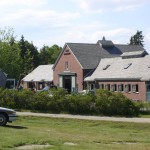 The magazine has been operating the WoodenBoat School for 27 years. The school manages 99 courses over the duration of the summer months. Most courses are one week, with a few running two weeks. I’m attending the ever popular two week “Fundamentals” of Boatbuilding” course, which runs 5 times each summer. Course instruction rotates among several highly respected wooden boat builders, each teaching one or more iterations each year. The instructor for my iteration is Greg Rössell, who builds with traditional techniques and operates a sole proprietorship boat shop in Troy, Maine.
The magazine has been operating the WoodenBoat School for 27 years. The school manages 99 courses over the duration of the summer months. Most courses are one week, with a few running two weeks. I’m attending the ever popular two week “Fundamentals” of Boatbuilding” course, which runs 5 times each summer. Course instruction rotates among several highly respected wooden boat builders, each teaching one or more iterations each year. The instructor for my iteration is Greg Rössell, who builds with traditional techniques and operates a sole proprietorship boat shop in Troy, Maine.
Greg promotes traditional boatbuilding. That means using traditional materials, local wood varieties, and traditional building techniques … as opposed to building epoxy embalmed boats, or tortured plywood boats. I can see the course curriculum following fairly close to the material in Greg’s books, “Building Small Boats” and “The Boatbuilder’s Apprentice.” It doesn’t take long to recognize expertise, and Greg has it. He also has an entertaining style, always a bonus.
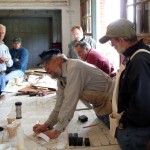 I’ve read Greg’s books and magazine articles for several years and have what I think is a good general understanding of what he teaches. What I lack is practical experience, and more importantly, knowledge of what to do when things don’t go exactly according to plan. That’s where this course excels. We get some time for practical hands on work, but more of the time is Greg’s instruction, and that instruction includes a tremendous amount of information about other ways of doing things and how to recover from things gone wrong.
I’ve read Greg’s books and magazine articles for several years and have what I think is a good general understanding of what he teaches. What I lack is practical experience, and more importantly, knowledge of what to do when things don’t go exactly according to plan. That’s where this course excels. We get some time for practical hands on work, but more of the time is Greg’s instruction, and that instruction includes a tremendous amount of information about other ways of doing things and how to recover from things gone wrong.
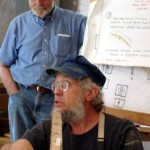
The typical day is part instruction and part hands on work. Most days, the work is the lesser part of the time. Instruction, not step-by-step “do this – do that,” is explanation and demonstration of techniques. We’re swimming in information and taking every opportunity to get all of our curious questions settled. The course follows the logical progression of building a boat: materials, woods, fastenings, glues, understanding lines and drawings, lofting, setting up building molds and other jig parts, setting up stems keels and transoms, planking, joinery, spar making, and on and on.
Sometimes a colleague stops by. That’s Maynard Bray, frequent WoodenBoat author, standing by the “powerpoint display device.”
We are working on two boats and will complete neither. One is a Chaisson semi-dory. The other is a Whitehall. Each offers unique building lessons.
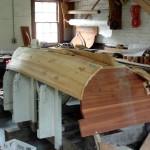 The Chaisson, being basically a dory has a flat bottom and lapstrake planking. It is built upside down over four molds and has light frames bent into it after planking is complete. Planks fasten to each other, mostly with copper rivets. It is called a semi-dory because it has a transom that is broader than most dories and has lines that make the hull more rounded than most dories. It’s a very pretty small boat. The one we have in the shop is partially planked and will be off the molds and turned over next week.
The Chaisson, being basically a dory has a flat bottom and lapstrake planking. It is built upside down over four molds and has light frames bent into it after planking is complete. Planks fasten to each other, mostly with copper rivets. It is called a semi-dory because it has a transom that is broader than most dories and has lines that make the hull more rounded than most dories. It’s a very pretty small boat. The one we have in the shop is partially planked and will be off the molds and turned over next week.
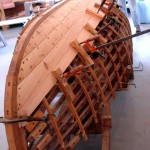 The Whitehall is a round bottomed boat that is carvel planked. It is built upside down over its frames. The frames are bent over ribbands supported by molds. The jig is substantially more complex than the one used for the Chaisson. Planks fasten directly to the frames with screws. Ours is called a “baby” Whitehall because it is shorter than most. Yet, it is not so short as to make it look bad. It has very sweet lines. It wants to have 10 planks per side and currently has 4 on one side and 3 on the other. Lots of work remains and we won’t see it fully planked.
The Whitehall is a round bottomed boat that is carvel planked. It is built upside down over its frames. The frames are bent over ribbands supported by molds. The jig is substantially more complex than the one used for the Chaisson. Planks fasten directly to the frames with screws. Ours is called a “baby” Whitehall because it is shorter than most. Yet, it is not so short as to make it look bad. It has very sweet lines. It wants to have 10 planks per side and currently has 4 on one side and 3 on the other. Lots of work remains and we won’t see it fully planked.
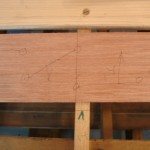 One of our work sessions this week was spiling and getting out a plank. Spiling is thought to be some form of black magic. At least that’s what it sounds like when reading about it. Actually, it is only two parts black magic and one part semi-Euclidiean geometry. Take 48 measurements per pank. Find a suitable piece of wood. Transfer the 48 measurements. Connect the dots, very smoothly of course, and that’s spiling. Then get the plank out of the wood by removing all parts that are not plank, and affix it to the boat. Simple! It took my partner Paddy and I about 8-9 hours to spile, get out, and hang our first plank. We learned lots, about 17 tricks and 38 pitfalls. Greg’s reaction was, “Women and children will squeal with delight.” We’re not sure he was talking about the plank.
One of our work sessions this week was spiling and getting out a plank. Spiling is thought to be some form of black magic. At least that’s what it sounds like when reading about it. Actually, it is only two parts black magic and one part semi-Euclidiean geometry. Take 48 measurements per pank. Find a suitable piece of wood. Transfer the 48 measurements. Connect the dots, very smoothly of course, and that’s spiling. Then get the plank out of the wood by removing all parts that are not plank, and affix it to the boat. Simple! It took my partner Paddy and I about 8-9 hours to spile, get out, and hang our first plank. We learned lots, about 17 tricks and 38 pitfalls. Greg’s reaction was, “Women and children will squeal with delight.” We’re not sure he was talking about the plank.
Other hands on tasks this week included making two new transoms, making a new Chaisson bottom, making a new Chaisson stem. All of these were for the next boats, not the current ones. There were also a variety of “fix this” activities.
Maybe it’s the students who should squeal with delight. There is universal agreement that it was a very good week.
I would like your input on two boat I would like to build. #1 Whitehall Pulling
Boat 17’plans detailed in John Gardner,BUILDING CLASSIC SMALL CRAFT Volume#1.
#2 Sea Bright Skiff 16’plans detailed in John Gardner,BUILDING CLASSIC SMALL CRAFT
Volume #1.
The boat would be used for rowing and fishing on Wisconsin inland waters. I have
built three boats,The 6 Hour Canoe,plans from WoodenBoat,the Wisp plans from
Ultralight Boatbuilding Thomas J. Hill, and the Footloose plans Jorden Wood Boats.
Michael Mantel
Hobbyist/Builder
Tel 262-628-9926 Fax 262-628-9926
Hello Michael,
You have built more boats than I have. I should be asking your advice!
I’m familiar with both of the boats you mention. Yet, I can’t suggest one over the other for you. They are both very solid boats. I am guessing that the Sea Bright might be a bit more stable for fishing, while the Whitehall being a bit narrower might be a bit faster for those rowing workouts … but that’s only a guess. Their lines are quite similar, and I imagine their handling would be too. I have precious little rowing experience, but did immensely enjoy rowing a Whitehall at the Wooden Boat School
Both are also a bit more work than your previous boats, being traditionally constructed, but it sounds as if you’re ready for that. I find both those boats very appealing, but have far too little experience to recommend one or the other.
Do you visit the WoodenBoat Forums? You might pose a question in the “Design / Plans” forum. There are usually many opinions, sometimes from people with actual experience. 🙂
Do you have any online pictures of the boats you’ve built so far?
Best luck with whichever you decide to build. Both look rewarding.
Dear Sirs,
I am from Latvia. We are going to build wooden boat a copy of famous Whitehall of wooden planks ultimate close to original technology. We are experienced woodworkers but never built any boat. Therefore we would like have training at your workshop. Is it possible? What are conditions?
Thanks,
Best regards,
Arnis Zhagata
Arnis,
My workshop is not the right place for you to learn what you want to know. Yes, I have some of the knowledge, but my shop is simply a small home workshop, too small for teaching.
You will do much better attending courses at the Wooden Boat School in Brooklyn Maine.
You can find their course catalog at < a href="http://www.thewoodenboatschool.com/index.php">this link.
Good luck with your interest in wooden boats, and the Whitehall in particular. I’m sure you will enjoy the project.
Hello
I am about ready to start on my first traditional style wooden boat. I have had a very unique way of learning this ancient technique. while traveling by bicycle in Chilean Patagonia, I came across the opportunity to live on an island with a family. Very far away from technology and civilization. They made wooden boats there out of cypress. i fell in love with the art, but have never made one myself. I am now back in minnesota getting ready to start. I have a few questions and was wondering if you had the answers. Most of the questions relate to the differences in technology that exist and the materials that i will have to choose from. In southern chile the people are very poor and in the case of the island, materials were not abundant or available.
1. what type of connectors would you recommend to fasten the planks of the hull to the ribbing of the boat? in chile we simply used galvanized nails and doubled them over on the inside to re-strengthen the hold. I was wanting a better finish without having nails bent over on the inside. Smaller nails that do not go through all the way would not be nearly as strong. Are Rivets an option? What are some pros and cons for this?
2. as far as plugging the gaps between the planks we used a nylon rope and then filled with a puddy made from chalk and a oil based paint. what are your recommendations for materials for this?
3. and finally for the finish. in chile we used a standard oil based synthetic paint, but in the states we have much better technology with epoxys, fiber glass and so forth. if i go through the process to build a beautiful wooden boat i definitely do not want to cover it with paint. i want to see the wood grains. what would be the process….first a stain? and then epoxy or a varnish? if i use an epoxy do i need fiber glass or does the epoxy act as a protectant and sealer when used alone?
I hope you find some time to respond to my questions, it would be greatly appreciated! thank you very much
Welcome Michael.
Please excuse the tardy response; I’ve been away from the blog a few days. Your travels in Patagonia sound fantastic. The methods you saw there are time proven and really not much different today.
Reading my diary of building Eva Won will answer your questions, including references to certain materials and sources. Yet, here are a few answers.
Fasteners: the bent over nail, clenched as boatbuilders call it, is an incredibly strong fastening. The only thing we do differently than the Chileans is using cut cooper nails instead of galvanized. Sadly the copper nails are becoming difficult to find and are expensive. Clenched nails are a lot faster than riveting and particularly suitable for very liggt craft such as canoes. Heavier planking used on pretty round bottom boats benefit from riveting … again in copper.
Caulk: The Chilean method works perfectly, even today. For carvel planked boats, the traditional boatbuilder uses either wool or cotton stuffing and almost any flexible paint for sealing. For overlapping planks, I use a synthetic caulk (don’t remember exactly which, but it is in the blog). The most important aspect is to use something that will remain flexible and completely renewable.
Finish: the desire for “bright” finish is very understandable, especially when you work with beautiful lumber. The downside is cost and durability. Those beautiful yachts with polished mahogany need annual varnish renewal. My choice was a working man’s compromise: paint on the bottom and especially where it will see damage, and a translucent finish on the deck. The Cetol finish is not as bright as clear varnish, but is much more durable. … which is the result of more UV inhibitors that provide the durability while also clouding the result a bit.
Have a fabulous time building …. and start a blog to show us your progress.